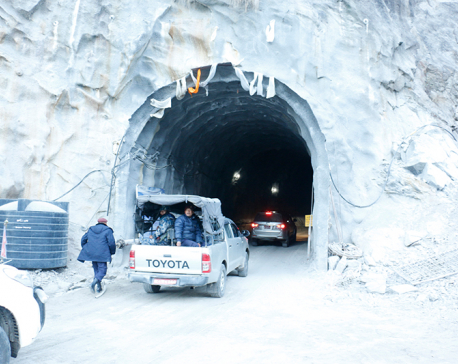
OR
SIDELINES

No matter how instable the polity is or how poor and ignorant the populace are, Nepal is accursed to wallow in its sovereign misery as long as the balance of power does not change
Just like the dress and address, concerns of a person also reflect one’s class in an unmistakable manner. When members of the Upper Class meet, they talk about paucity of domestic help or the challenges of retaining skilled chauffeurs. The Middle Class has middling concerns: next EMI, school admissions, traffic snarls, quality of Chinese wines, and the best place for crusty pizza in town.
The Working Class is perpetually on the lookout for a visa to anywhere in the world to escape the tedium of remaining in the same place despite running nonstop. The Under Class has no time to worry—it survives and vents its frustrations by cursing either the fate or the politicians.
In between the Upper and the Middle above and the Working and the Under below, there is a thin band of salaried professionals, self-employed specialist, skilled entrepreneurs and the rentier bourgeoisie that form the Comfortable Class (CC) with enough leisure at hand to engage itself with common concerns. The Kathmandu CC is obsessed with conspiracy theories with imminent villains and eminent saviors that are mostly of its own making.
Most, though admittedly not all, White Shirts (WS, pronounced Dabloos) come from the CC background. Analogous to the Yellow Shirts of Thailand in its composition, beliefs and concerns, the Dabloos of Nepal form a cohort of weekend warriors that constantly need a recognizable figure of hate to channel its negative energy. After 2008, Pushpa Kamal Dahal was the main villain. For a brief period, Baburam Bhattarai perfectly fitted the bill with his inclusive proclivities. They then discovered Rajendra Mahato with skin color and hirsute visage perfect for caricature.
The latest object of wrath is Lokman Singh Karki, head of a constitutional body that is designed to be much more than a mere watchdog. Any person with an iota of political ambition can easily turn the CIAA into a super government. And that precisely is the conspiracy theory doing the rounds of CCs in general and Dabloos in particular.
The rumor doing the Dabloo rounds is that the ‘foreign forces’ are plotting to subvert the system and preparing for another extra-constitutional government under proposed President Khil Raj Regmi and presumptuous Premier LSK to prepare yet another constitution! It’s in the character of rumors that the more farfetched the insinuation, the more plausible it sounds.
It may appear like pop psychology and intuitive sociology, but beliefs, values, behaviour patterns, and ways of living of a cohort are born out of circumstances of political economy of its formative years. Most of Dabloos belong to the Referendum Generation and were born and brought up after 1975—the year of coronation of foreign-educated monarch. The Chief Commissioner LSK honed his manipulative skills precisely during this period.
Writing about circumstances leading to the rise of Napoleon Bonaparte, “the king of the French Revolution”, historian François Furet notes, “In 1789, the French had created a Republic, under the name of a monarchy. Ten years later, they created a monarchy, under the name of a Republic.” Does Nepal really run the risk of rise of Caesarism? The answer probably needs a careful evaluation of country’s geopolitical and socioeconomic compulsions.
Contested context
It’s in the nature of history that it never lets go of its grip over the collective imagination. Starting with the military campaigns of Gorkhali warriors till the Treaty of Sugauli in 1814-16, the emergence of Khas strongman Jang Bahadur Kunwar in 1846, and the brief interlude of democracy between 1950 and 1960 followed by the royal-military coup, each historic episode has helped shape the self-definition of the Nepali people.
However, by virtue of its comprehensiveness, the Referendum of 1980 continues to be the cataclysmic event that confined the idea of being a Nepali into a narrow quadrant of egocentrism, ethnocentrism, xenophobia and McCarthyism. The chain of events in the wake of Referendum strengthened the self-perception of ‘patriotic’ Nepalis as being constantly at the risk of losing its identity. The aggressiveness of nationalists comes from fears that have little base in reality.
Even though rigged, the result of the plebiscite conferred post-facto legitimacy upon the royal-military coup of 1960 that King Mahendra had staged to concentrate state powers in the institution of monarchy. It established the centrality of the king in public life and made a leader of BP Koirala’s stature proclaim publicly that the future of Nepali nationality was inextricably intertwined with the fate of monarchy. Sacredness of military was its natural corollary with the Supreme Commander-in-Chief as the ultimate protector of national interest.
Emboldened by results of plebiscite, King Birendra began to take steps that continue to confront the country even after the overthrow of monarchy.
On the domestic front, monarchical minions came up with the report of the Task Force on Internal and International Migration—the so-called Harka Gurung Report—that sought to ‘otherize’ all Madheshis and misrepresented the demographic fact that most migration into the Madhesh was from hills and mountains rather than from across the border.
On the international front, King Birendra put the geostrategic kingdom firmly in the Western Camp of Cold War and irked New Delhi by vigorously pursuing his “Zone of Peace” vision as the single-point agenda of foreign policy mission. Based on the Nixon Doctrine, Maoists were allies to be used against Marxists. By the end of the decade, he was buying anti-aircraft guns from China and provoking India at international forums to see how far he could go in exercising his sovereignty.
Nepal soon discovered that the right of access to the sea for landlocked countries read well only on paper; in practice, it continues to be a concession that has to be earned at the cost of continuous loyalty. In international relations, there indeed are no friends or foes; the only reality is the clash, negotiation, and resolution of conflicting interests.
When King Birendra handed over the administration to the political parties in 1990, Nepal had begun to show all symptoms of what political scientist Robert Jackson had called a “disintegrating state”. In the early-1990, Nepal indeed lacked “the characteristics of a common public realm” and the state of the state was such that the state offices possessed uncertain authority, government organizations were ineffective and plagued by corruption, and the political community was highly segmented ethnically into several ‘publics’ rather than one collective with shared imagination of national identity. Jackson’s other criteria—“corruption and incompetence infiltrate virtually every agency of government, not merely hampering but in most cases undermining state autonomy and capacity”—were even more visible.
However, not all disintegrating states ultimately fall apart. Once again, Jackson gives the reason. The constitutive norm of sovereignty in the international system allows states with virtually no capacity to effectively govern itself to exist and function. This is what from political scientist Leo E Rose to jurist Ganesh Raj Sharma have cited as the main reason for the continued independence and sovereignty of a country as ungovernable as Nepal.
No matter how instable the polity is or how poor and ignorant the populace are, Nepal is accursed to wallow in its sovereign misery as long as the balance of power does not change in the Himalayan region. The fears of ‘US imperialism’, ‘Indian expansionism’ or ‘Chinese embrace’ have all been equally exaggerated to say the least.
Designed malfunction
Even though the risks to the integrity of the country are entirely internal, external forces can’t be kept out in the name of sovereignty in the modern world. Like the extra-constitutional government of KRR, LSK is more of a product rather than the producer of the political drama of 2013-14 and the divisive ‘constitution’ it ultimately came up with.
More than everybody else, LSK knows the role he played to marginalize Madheshis and cut Maoists down to size with the help of the administration and security forces at the behest of the PEON. He also knows that Dabloos are direct beneficiaries of his shenanigans. There is a reason KRR as the Chairman of the council created to conduct elections had claimed that without LSK he wouldn’t be able to deliver expected results. It’s easy to be an idealist, but the fact is that LSK is the keystone of the PEON arch: Pull him out forcefully and the whole post-2013 structure will begin to crumble.
The more practical option is to limit CIAA’s role into investigations. Absolute power is prone to absolute misuse. LSK’s predecessor was no angel and his successors are unlikely to fall from heavens. Lawmakers need to ignore the Dabloos and concentrate on constitutional amendments to control their Frankenstein.
You May Like This

Govt allocates Rs 2.4 billion for Asian Games, SAG and National Games
KATHMANDU, May 30: Finance Minister Yubaraj Khatiwada has allocated Rs 2.4 billion for organizing the 18th Asian Games, the 13th South... Read More...

Tamakoshi power developer to generate power by one and half years
LAMABAGAR(Dolakha), Dec 21: Works to develop the 456-Megawatt Upper Tamakoshi Hydropower Project based in Dolakha are going on in full... Read More...

Sunkoshi Hydro Power Project starts generating more power
CHAUTARA, Sept 4: The Sunkoshi Hydro Power Project, which was partially damaged during a monsoon-triggered flooding in the Bhotekoshi River... Read More...




_20220508065243.jpg)
Just In
- MoHP cautions docs working in govt hospitals not to work in private ones
- Over 400,000 tourists visited Mustang by road last year
- 19 hydropower projects to be showcased at investment summit
- Global oil and gold prices surge as Israel retaliates against Iran
- Sajha Yatayat cancels CEO appointment process for lack of candidates
- Govt padlocks Nepal Scouts’ property illegally occupied by NC lawmaker Deepak Khadka
- FWEAN meets with President Paudel to solicit support for women entrepreneurship
- Koshi provincial assembly passes resolution motion calling for special session by majority votes














Leave A Comment